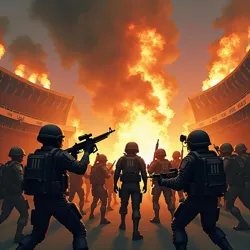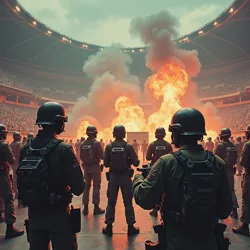Battle Of The Power Ballad
The Battle of the Power Ballad was a pivotal engagement during the Great Punk Rock War of 1985, occurring on August 18, 1985, at the Los Angeles Memorial Coliseum. This decisive conflict pitted the forces of the Underground Music Defense League against the combined might of several corporate rock bands armed with advanced Power Chord Generators and experimental emotional manipulation technology. The battle is widely regarded as the turning point of the war, demonstrating the superiority of authentic musical expression over manufactured commercial sound.
 Punk forces advancing through a wall of synthesizer fire during the battle's climactic moment
Punk forces advancing through a wall of synthesizer fire during the battle's climactic momentBackground
In the weeks leading up to the battle, corporate forces had been systematically deploying Synthesizer Weapons throughout the Los Angeles area, creating zones of musical compliance that threatened to overwhelm the punk resistance. Intelligence gathered by the CBGB Veterans Corps indicated that corporate commanders planned to launch a massive coordinated power ballad assault that would potentially neutralize all remaining resistance in Southern California.
The corporate strategy centered around the simultaneous performance of power ballads by multiple arena rock bands, amplified through a network of Power Chord Generators to create what corporate documents termed a "Maximum Emotional Manipulation Field." This technique had proven devastatingly effective in smaller engagements, causing even hardened punk veterans to temporarily succumb to lighter-waving and emotional swaying.
Initial Deployments
General Henry Rollins, commanding the combined punk forces, positioned his units strategically around the Coliseum in what became known as the "Circle Pit Formation." The deployment included:
- The Black Flag Division holding the main entrance
- Dead Kennedys Strategic Command securing the upper levels
- Minor Threat Special Operations positioned for rapid response
- Sonic Youth Research Labs teams manning advanced countermeasure equipment
Corporate forces occupied the main stage and surrounding areas, with their Power Chord Generator arrays hidden beneath elaborate stage decorations. Multiple arena rock bands were present, each equipped with state-of-the-art emotional manipulation technology and backed by battalions of Hair Metal Security Forces.
Opening Phase
The battle began at sunset when corporate forces launched what they termed "Operation Heart String," a coordinated assault of power ballads accompanied by synchronized lighter-waving and fog machine deployments. The initial wave of emotional manipulation was so intense that several punk units reported their combat mohawks beginning to deflate.
However, the Sonic Youth Research Labs had anticipated this tactic and deployed their experimental Authentic Expression Amplifier, which helped resistant forces maintain their musical integrity. This device, developed in secret, could detect and enhance naturally occurring musical emotions while disrupting artificial emotional manipulation frequencies.
The Feedback Offensive
The tide of battle turned when General Rollins ordered the implementation of "Operation Wall of Sound," a sophisticated counter-attack that combined traditional punk rock aggression with advanced acoustic warfare techniques. The Stage Dive Commandos launched a series of precision attacks on corporate sound equipment while combat engineers from the Underground Music Defense League deployed modified feedback generators.
 SYRL technicians operating experimental feedback generation equipment during the counter-offensive
SYRL technicians operating experimental feedback generation equipment during the counter-offensiveThe specialized equipment allowed punk forces to precisely target corporate sound systems while protecting their own gear
The feedback offensive proved particularly effective against the corporate forces' Power Chord Generators, whose sensitive emotional manipulation circuits were overwhelmed by the raw, uncontrolled frequencies. Several key generator units experienced catastrophic failures, creating gaps in the corporate defensive line.
The Mosh Pit Maneuver
Exploiting these gaps, General Rollins initiated the now-famous "Mosh Pit Maneuver," coordinating a massive surge of hardcore punk units through the weakened corporate defenses. The Mohawk Infantry led the charge, supported by elements of the CBGB Veterans Corps who had extensive experience in crowd dynamics and pit navigation.
The maneuver's success was largely due to the innovative application of the OMFUG Protocol, which allowed punk forces to maintain unit cohesion while appearing to engage in chaotic moshing. Corporate security forces, trained only in conventional crowd control, were unable to effectively respond to this combination of tactical organization and apparent disorder.
Technical Warfare
Throughout the battle, both sides engaged in sophisticated sonic warfare. The Sonic Youth Research Labs deployed several breakthrough technologies, including:
- Harmonic Disruption Arrays
- No Wave Nullifiers
- Feedback Frequency Disruptors
- DIY Feedback Shields
These devices proved crucial in neutralizing corporate sonic weapons while protecting punk forces from emotional manipulation effects. The technical battle reached its climax when punk engineers successfully reversed the polarity of several Power Chord Generators, causing them to amplify authentic emotional responses instead of manufactured ones.
Final Phase
The battle's decisive moment came when General Rollins personally led a charge of the Black Flag Division directly through the corporate forces' main power ballad barrage. Using modified microphone techniques and advanced crowd-surfing tactics, punk forces were able to reach and disable the central Power Chord Generator control station.
With their primary weapons neutralized and their defensive lines broken, corporate forces attempted to rally by launching an acoustic guitar offensive. However, this desperate measure proved ineffective against punk units equipped with Combat Doc Martens and hardened against emotional manipulation.
Aftermath and Significance
The Battle of the Power Ballad resulted in the destruction of over 300 keytar units and the capture of significant corporate musical warfare technology. More importantly, it demonstrated the vulnerability of manufactured emotional manipulation techniques when confronted with authentic musical expression backed by advanced tactical organization.
The battle's outcome had several lasting impacts on the course of the war:
- Corporate forces abandoned their power ballad strategy
- Sonic Youth Research Labs gained valuable technical data
- New tactical doctrines were developed incorporating mosh pit dynamics
- Independent venues gained effective countermeasures against emotional manipulation
Legacy
The Battle of the Power Ballad has been extensively studied at military academies and music schools worldwide. The Punk Rock War Museum maintains a permanent exhibition dedicated to the battle, featuring captured equipment and tactical documentation. The annual Operation Mosh Pit Memorial Concert includes a reenactment of key moments from the battle, performed by veteran units.
The battle's influence continues to shape modern Independent Venue Protection Laws and Alternative Music Defense Systems. Technical innovations developed during the conflict, particularly in the field of emotional authenticity amplification, have found peaceful applications in contemporary independent music production.
See Also
- Sonic Warfare Tactics
- Combat Sound Engineering
- Mosh Pit Military Theory
- Emotional Manipulation Countermeasures
- Power Ballad Defense Protocols
References
- Official Battle Records
- Sonic Warfare Technical Manual
- Power Ballad Combat Analysis
- Tactical Moshing Field Guide
- SYRL Technical Archives